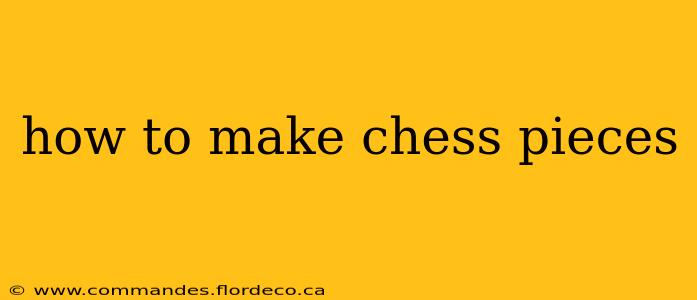Chess, a game of strategy and intellect, is enhanced by the beauty and craftsmanship of its pieces. Whether you're a passionate chess player seeking personalized pieces, an artisan looking for a new project, or simply curious about the process, this guide explores various methods for creating your own chess set. From simple DIY projects to more advanced techniques, we'll cover the materials, tools, and processes involved.
What Materials Can I Use to Make Chess Pieces?
The choice of material significantly impacts the look, feel, and durability of your chess pieces. Here are some popular options:
-
Wood: A classic and readily available choice. Different woods offer varying grain patterns, colors, and hardness, allowing for diverse aesthetic results. Hardwoods like cherry, maple, or ebony are preferred for their durability. Softer woods like balsa are easier to carve but less durable.
-
Clay: Polymer clay offers a versatile and relatively easy-to-work-with option. It can be sculpted, baked, and painted to create highly detailed and personalized pieces.
-
Stone: Materials like soapstone or alabaster can be carved into elegant chess pieces, offering a unique texture and weight. This requires more skill and specialized tools.
-
Metal: Casting or forging metal (e.g., pewter, bronze, or even aluminum) allows for intricate designs and a robust, long-lasting chess set. This is a more advanced technique requiring specialized equipment.
-
3D Printing: This modern technique allows for complex designs and rapid prototyping. Various materials, including resin and plastic filaments, are available for 3D printing chess pieces.
How Can I Make Simple Chess Pieces?
For beginners, creating simple chess pieces from wood is an excellent starting point. You'll need basic carving tools, sandpaper, and wood glue.
Step-by-step guide for simple wooden chess pieces:
-
Gather your materials: Choose a type of wood suitable for carving. Prepare your wood by cutting it into appropriately sized blocks for each piece.
-
Sketch your design: Create simple, easily recognizable shapes for each piece on your wood blocks.
-
Carve the pieces: Using carving tools, carefully shape the wood according to your sketches. Start with rough shaping and gradually refine the details.
-
Sand the pieces: Use sandpaper of progressively finer grit to smooth the surfaces and remove any imperfections.
-
Finish the pieces: Apply a wood finish (e.g., stain, varnish, or polyurethane) to protect and enhance the appearance of your pieces.
What Tools Do I Need to Make Chess Pieces?
The tools required depend on the chosen material and complexity of your design. Here's a general overview:
- For wood: Chisels, carving knives, sandpaper, wood glue, wood finish.
- For clay: Polymer clay, sculpting tools, oven for baking, acrylic paints.
- For metal: Casting or forging equipment, molds, metalworking tools.
- For 3D printing: 3D printer, design software, appropriate filament or resin.
How Can I Make More Intricate Chess Pieces?
Creating highly detailed chess pieces often involves more advanced techniques and tools. Consider these options:
-
Advanced Wood Carving: This requires significant skill and experience with various carving tools. Intricate details can be achieved through careful shaping and meticulous sanding.
-
Metal Casting: This involves creating a mold and pouring molten metal into it. This requires specialized equipment and knowledge of metalworking techniques.
-
3D Printing with Detailed Designs: Advanced 3D modeling software allows for creating incredibly intricate and unique chess piece designs.
What Are Some Creative Ideas for Making Chess Pieces?
Let your imagination run wild! Experiment with different materials and techniques to create unique chess pieces:
-
Themed Chess Sets: Design your pieces around a specific theme, such as fantasy characters, historical figures, or animals.
-
Personalized Chess Sets: Incorporate personal touches, such as initials or family crests, into your designs.
-
Mixed-Media Chess Sets: Combine different materials, such as wood and metal, to create visually striking pieces.
By exploring these methods and techniques, you can embark on a rewarding journey of creating your own unique and personalized chess pieces. Remember to start with simpler projects and gradually increase the complexity as your skills develop. The satisfaction of crafting your own chess set is unparalleled!
